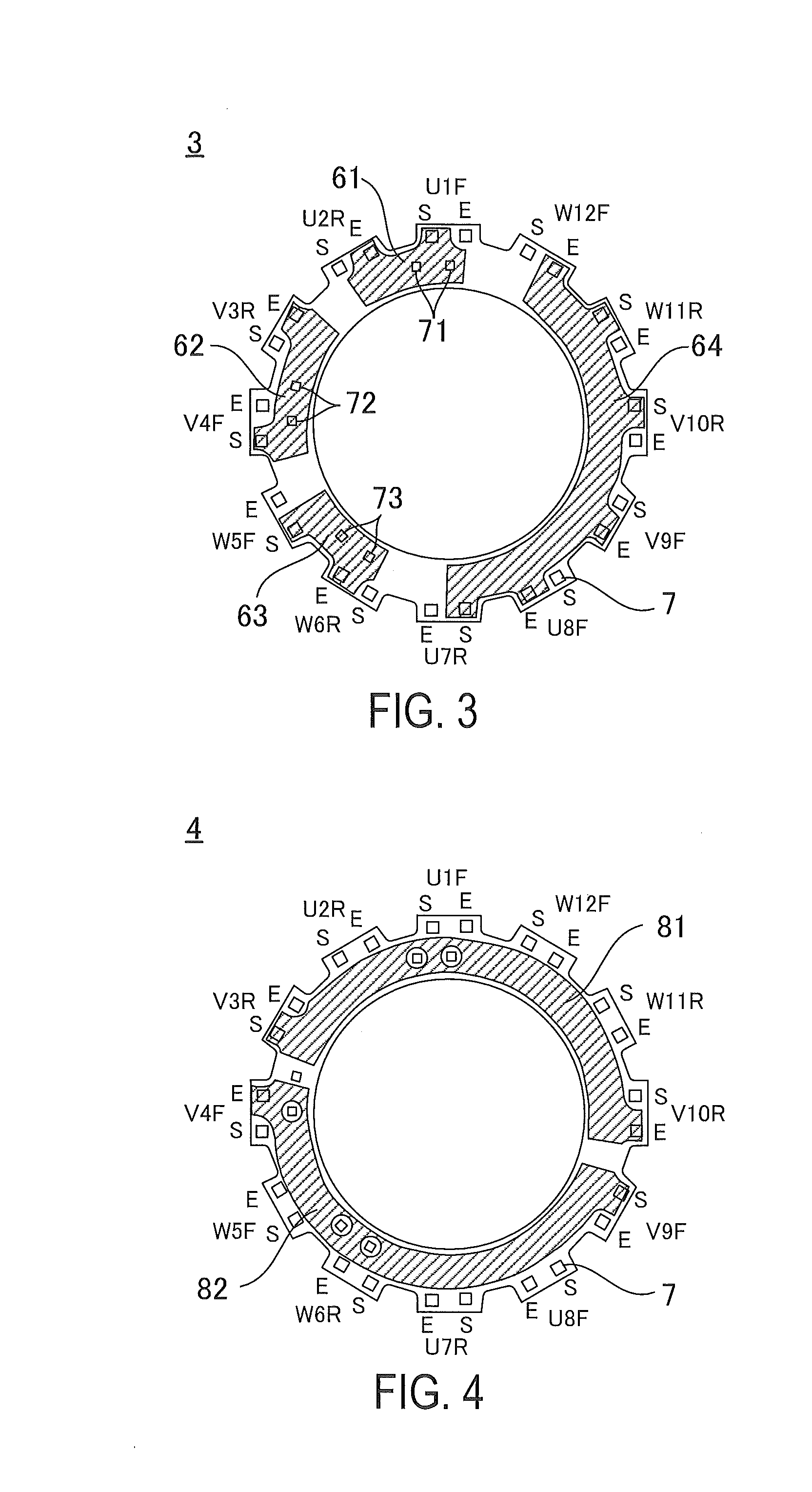Three-phase permanent magnet type motor
- Summary
- Abstract
- Description
- Claims
- Application Information
AI Technical Summary
Benefits of technology
Problems solved by technology
Method used
Image
Examples
first embodiment
[0036]First, a configuration of the three-phase permanent magnet type motor of the first embodiment will be described with reference to FIG. 1. FIG. 1 is a schematic cross-sectional view of a three-phase permanent magnet type motor according to the first embodiment.
[0037]As illustrated in FIG. 1, for example, a three-phase permanent magnet type motor 100 of the first embodiment is configured as an SPM motor (Surface Permanent Magnet Motor) with 10 poles and 12 slots.
[0038]The three-phase permanent magnet type motor 100 of the present embodiment includes a rotor 1, a stator 2, and multilayer wiring boards 3 to 6.
[0039]The rotor 1 has a rotor core 10 and a permanent magnet 20.
[0040]The rotor core 10 is a cylindrical metallic member. As structural materials of the rotor core 10, for example, soft magnetic materials such as silicon steel plate are used, but the materials are not limited to the exemplary material.
[0041]The rotor 1 of the SPM motor is configured so that a ring-shaped perm...
second embodiment
[0083]Next, a configuration of a three-phase permanent magnet type motor of a second embodiment will be described with reference to FIG. 7. FIG. 7 is a schematic cross-sectional view of the three-phase permanent magnet type motor according to the second embodiment. In addition, the same structural members as those of the first embodiment will be described while being denoted by the same reference numerals.
[0084]A three-phase permanent magnet type motor 200 according to the second embodiment is different from that of the first embodiment in the arrangement of the division core 31, the arrangement of the windings of three-phase Y connection, and the structures of the multilayer wiring boards 203 to 206.
[0085]In FIG. 7, reference numerals added on the winding 40 will be described. A positional relation between a circuit connection diagram described below and the multilayer wiring board becomes clear, by the reference numerals of each winding 40. First, the distinctions of the three pha...
third embodiment
[0112]Next, a configuration of a three-phase permanent magnet type motor according to a third embodiment will be described with reference to FIG. 13. FIG. 13 is a schematic cross-sectional view of the rotor used in the three-phase permanent magnet type motor according to the third embodiment. In addition, the same structural members as those of the first embodiment will be described while being denoted by the same reference numerals.
[0113]A three-phase permanent magnet type motor 300 according to the third embodiment is different from that of the first embodiment in a structure of a rotor 301.
[0114]For example, a rotor 301 illustrated in FIG. 13 is configured as a consequent pole type IPM motor (Interior Permanent Magnet Motor) with 10 poles.
[0115]The rotor 301 is provided around the rotary shaft 8, and has a rotor core (an iron core) 310, and a permanent magnet 320. The rotary shaft 8 serves as a center of rotation of the rotor 301.
[0116]The rotor core 310 is a metallic member havi...
PUM
 Login to View More
Login to View More Abstract
Description
Claims
Application Information
 Login to View More
Login to View More - R&D
- Intellectual Property
- Life Sciences
- Materials
- Tech Scout
- Unparalleled Data Quality
- Higher Quality Content
- 60% Fewer Hallucinations
Browse by: Latest US Patents, China's latest patents, Technical Efficacy Thesaurus, Application Domain, Technology Topic, Popular Technical Reports.
© 2025 PatSnap. All rights reserved.Legal|Privacy policy|Modern Slavery Act Transparency Statement|Sitemap|About US| Contact US: help@patsnap.com



